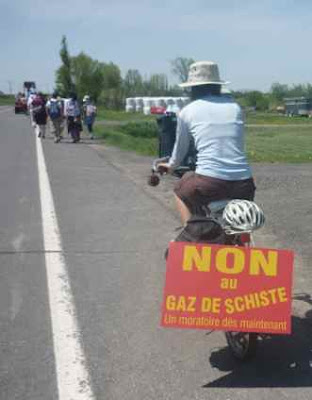The word "staycation" was coined a few years ago to describe vacations where we stay in our home area. While many people do this for economic reasons, I value "staycationing" for its ecological sense. I gave up on airplanes in 2004, but since then have done significant motorized land travel around North America, mostly for the personal enjoyment of seeing beautiful places. In the last two years, I've shifted my vacationing primarily to bike-driven destinations, and have found this type of travel more valuable and rewarding, and the places I visit just as beautiful. This winter, I made my first attempts at sub-zero staycationing in our glorious nordic environment.
Each year we have a multi-day winter bike ride in Québec called Action Citoyenne à Vélo (more info here and here), where a group of riders roam around the landscape regardless of the weather: rain or shine or sleet or snow. In previous years they rode for 3-4 days around the countryside. This year (my first time), we took two days to ride 100km around Québec City, stopping to see the tourist attractions of Old Québec, the waterfall at Kabir Kouba, and the impressive hills north of the city.
Visiting the sights around Québec City
We spent an afternoon climbing through the hills, generating heat through the internal combustion of our bodies, despite it being one of the coldest weekends of the year (varying between -12C and -20C). I frequently had to stop to cool off or remove layers (though cheated a little by using heating pads for my fingers and toes since it was an especially cold weekend). There was a moment of absurdity when we pushed our bikes through half a kilometre of impossibly deep snow... taking this "short cut" seemed like the most adventurous option, so we embarked. Just before emerging from the woods, we were greeted by a snow-dappled lazy river. There is something glorious in hiking along a snowy mountain pass, brought there by the power of our own energies.
Doing a group ride bolstered my confidence and enthusiasm for winter biking. Before I was learning to ride in the winter because it fits with my ecological values. Now I'm enthralled by winter riding because it's freeing, relaxing and a fantastic way to appreciate the outdoors in Canada.
Yesterday I received an invitation to go polar-bear plunging in an icy river with my family farmer, who has been snow-bathing since his childhood. Being a balmy -2C, atypically warm for February, it seemed like the right time to become intiated in the extreme art of winter river plunging. A 30km round-trip bike ride, we hiked down to a gorgeous river bed, and took a 5-second jump into the frigid water as the sun set. Afterward, aside from cold feet, the surrounding air feels warm. There's no need to travel across the world to enjoy a sunset or a beautiful landscape; and no need to travel by motorized vehicles to have thrilling experiences.
Local sights with my local farmer
When traveling by bike, or on foot, we see more than we would typically see on other types of vacations. When moving at a few kilometres an hour, we can always stop to appreciate the details, rather than driving or flying past them. We discover and value the beauty of our region, and become acutely aware of the landscape and weather conditions that surround us. And best of all, if we like where we visit or make connections with people along the way, it's always accessible and ecological to repeat the experience.meghan




















